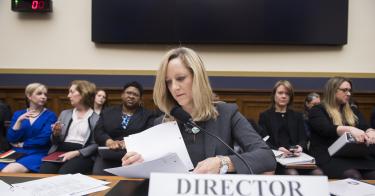Much hard work remains, but the Trump administration has taken a major step toward reforming the housing finance system. Despite enormous pressure from special interest groups, the Consumer Financial Protection Bureau has announced that it will do the right thing and end the infamous QM patch.
For those new to this issue, the QM patch is the loophole in the 2013 qualified mortgage (QM) rule that gave special treatment to loans eligible for purchase by Fannie and Freddie. It is set to expire in 2021 (or if Fannie and Freddie are no longer in conservatorship, whichever happens first), but the housing lobby has been pulling out all the stops to convince the bureau to extend and expand the patch.
Last Thursday, CFPB Director Kathy Kraninger made it perfectly clear that her agency would close this loophole. At a press conference, where she was joined by new FHFA Director, Mark Calabria, Kraninger told reporters: “The top line is the patch is going to expire.”
Reforms are long overdue, so both taxpayers and prospective homeowners should thank Kraninger and her CFBP colleagues.
They should also be grateful to Calabria and his FHFA colleagues – the fact that Calabria, the chief regulator for Fannie and Freddie, joined Kraninger at the press conference was a strong sign of solidarity. Calabria noted that the patch “exacerbates an unlevel playing field” in the mortgage market and said that he believes “Fannie and Freddie should play by the same rules as everyone else.”
At the very least, it is a breath of fresh air to see U.S. regulators reconsidering flawed regulations. With any luck, this move will turn out to be the first of many reversals of federal policies that have made homes less affordable for low- and moderate-income buyers.
A full decade has passed since the 2008 mortgage meltdown, yet virtually the same system remains in place. Congress whiffed on making any meaningful reforms to the housing finance sector, and the CFPB, under former director Richard Cordray, made a bad situation even worse by making sure that the QM rule had very few teeth.
As a result, the QM patch has simply allowed Fannie and Freddie to continue to fund loans with higher risk than what was originally intended for the QM. To be sure, the QM itself, along with Dodd-Frank’s “ability to repay” standard, is bad policy.
The ability-to-repay standard turned common sense on its head by exposing lenders to legal liability for borrowers unable to repay their debts. (Nobody wants banks to make bad loans, but this framework was an ill-conceived way to accomplish that goal.) At the same time, the QM gave lenders a safe harbor from that legal liability. The general idea was that if a loan met the QM standard, a sort of a minimum-quality mortgage, the lender was safe.
This scheme was a terrible idea because it gave lenders every incentive to make only QM loans. It was easy to predict that lenders would avoid writing non-QM loans for everyone except those with pristine credit. It was even easier to predict that financial firms would want a specific list of regulator-sanctioned underwriting guidelines to ensure compliance.
All of this has come to fruition, but the bureau cannot ditch the QM and the ability to repay standard. Congress created the problem, and only Congress can truly fix it. However, the bureau can make this bad framework better, and that is exactly what it appears set to do.
At her press conference last week, Kraninger also announced the bureau was releasing an advance notice of a proposed rulemaking to seek public comment on possible amendments to the QM rule. Kraninger noted:
The national mortgage market readjusting away from the Patch can facilitate a more transparent, level playing field that ultimately benefits consumers through stronger consumer protection. We want to hear all perspectives on how to move beyond the GSE Patch, the impact on credit, the role of the private mortgage market, and possible modifications to the definition of qualified mortgages and the rules governing the documentation of debt and income. The Bureau is committed to ensuring a smooth and orderly mortgage market throughout its consideration of these issues and any resulting transition away from the GSE Patch.
Kraninger and her team have had to withstand enormous pressure to move in this direction – and they will have to withstand even more now – but it is clear that they are dead serious about doing the right thing for American taxpayers and borrowers.
This piece originally appeared in Forbes https://www.forbes.com/sites/norbertmichel/2019/07/29/kraningers-cfpb-takes-major-step-to-fix-housing-finance/#246b99ed2bea



